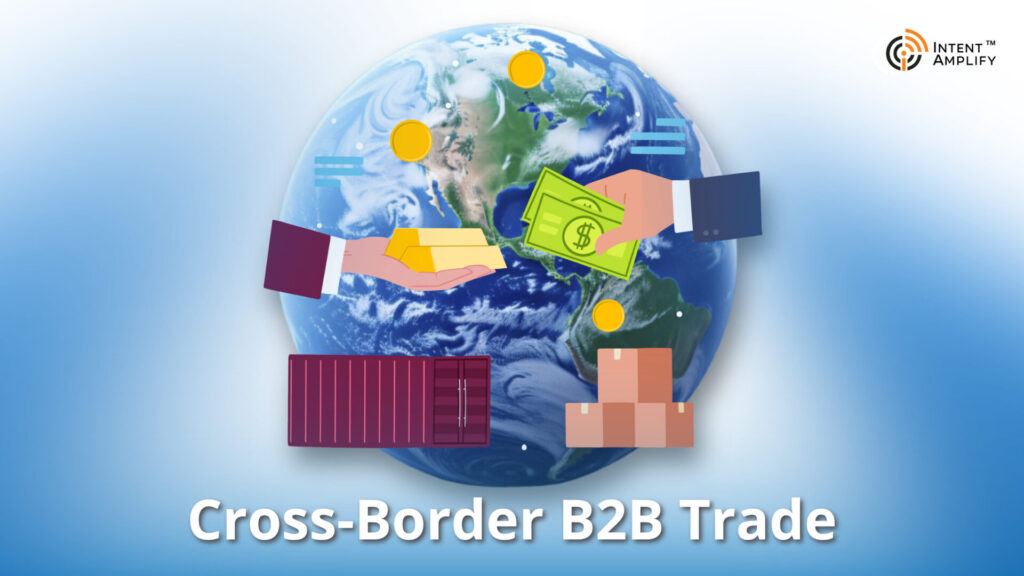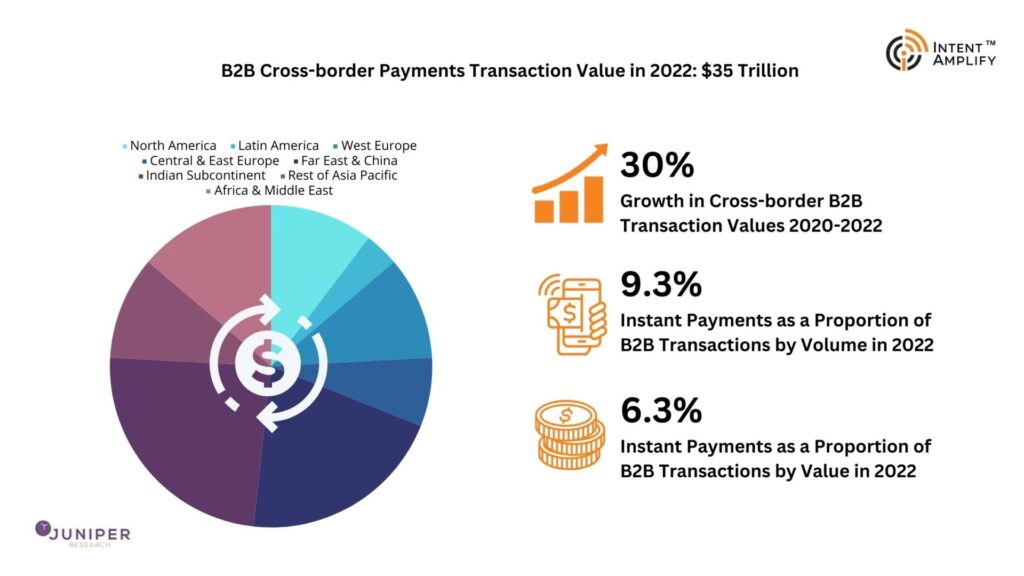
5 Key Considerations of Cross-Border B2B Trade
Commerce these days is no longer confined by physical borders. In today’s interconnected landscape, B2B trade has transcended national boundaries, presenting both captivating opportunities and complex challenges for businesses of all sizes. This dynamic phenomenon, known as cross-border B2B trade, has reshaped traditional business models and continues to evolve at an unprecedented pace.
But what exactly is cross-border B2B trade?
In its simplest form, it refers to the commercial exchange of goods and services between businesses located in different countries (divided by borders). This is not only restricted to straightforward product import/exports but also complex supply chain collaborations and joint ventures. The significance of international B2B trading lies in its potential to unlock new markets, expand customer bases, and fuel economic growth for both participating businesses and national economies.
Key considerations of cross-border B2B trade
A diverse range of players and stakeholders come into play, each with their own interests and objectives. From manufacturers and exporters to logistics providers and financial institutions, understanding the roles and responsibilities of each player is crucial for ensuring a smooth and successful transaction. Additionally, governments and regulatory bodies establish trade policies and agreements that impact the flow of goods and services across borders, adding another layer of complexity to the equation.
As a B2B demand generation agency, we know the value of effective communication and strategic planning in today’s globalized marketplace. In this blog, we will delve deeper into the dynamics of international B2B trade, exploring its complexities, challenges, and the myriad opportunities it presents for forward-thinking businesses.
- Market Dynamics
Beyond the technical and logistical considerations, success in cross-border B2B trade hinges on a keen understanding of the ever-shifting currents of global markets.
How to navigate the ever-changing trade landscape?
- Stay abreast of global economic trends: Monitor fluctuations in exchange rates, economic growth indicators, and political developments that can impact trade flows and consumer behavior across different regions.
- Leverage technology and data: Utilize market research tools and e-commerce platforms to gain insights into regional market demands and identify potential growth opportunities.
- Go beyond averages: While understanding overall market trends is crucial, delve deeper to identify specific variations in demand within your target segments across different regions.
- Localize your approach: Cultural nuances, regulations, and even product preferences can differ significantly. Tailor your marketing messages, product offerings, and customer service strategies to resonate with local audiences.
- Embrace agility and continuous learning: Be prepared to adapt your strategies based on real-time market feedback and data-driven insights. The global market is dynamic, and continuous learning is essential for sustainable success.
- Regulatory Landscape
The bustling marketplace of cross-border B2B trade pulsates with opportunity, but traversing its regulatory landscape can feel like venturing into uncharted territory. Understanding and complying with international trade regulations, customs procedures, and tariffs is no walk in the park, but it’s a crucial step for ensuring a smooth and compliant journey.
How to navigate rules and regulations?
- Overview of international trade agreements: Familiarize yourself with relevant trade agreements like NAFTA, USMCA, and WTO that govern trade flows and tariffs between specific countries or regions. These agreements can significantly impact the cost and ease of conducting business across borders.
- Tariff classifications: Understanding the Harmonized System (HS) codes for your products is essential for determining applicable tariffs and duties. These codes act as the universal language for classifying traded goods, and incorrect classification can lead to delays and penalties.
- Stay informed: Regulatory landscapes constantly evolve. Subscribe to updates from relevant government agencies and trade associations to stay abreast of changing regulations and compliance requirements.
- Customs clearance procedures: Each country has its own customs clearance process, involving documentation requirements, inspections, and potential duty payments. Familiarize yourself with the specific procedures for your target markets to avoid delays and unexpected costs.
- Partnering with experts: Consider collaborating with customs brokers or freight forwarders who possess the expertise and local knowledge to navigate customs procedures efficiently and ensure compliance.
- Embracing technology: Several online tools and platforms can streamline customs clearance and documentation processes, saving you time and resources.
- Intellectual property rights: Understand and comply with intellectual property (IP) regulations in your target markets. Failing to do so can lead to legal disputes and reputational damage.
- Data privacy and security: Be mindful of data privacy regulations like GDPR and CCPA when transferring data across borders. Implement appropriate data security measures to protect sensitive information.
- Seek expert guidance: Consulting with legal and compliance professionals can provide invaluable guidance on navigating complex regulations and minimizing compliance risks.
- Cultural Nuances
The global business landscape is an ultra-complex web of diverse cultures, each with its unique threads of communication styles, etiquette, and business practices. While the potential rewards of cross-border B2B trade are alluring, overlooking cultural nuances can unravel even the most well-crafted business plans. To truly thrive in this area, understanding and adapting to cultural differences is paramount.
How to navigate the challenges of cultural differences?
- Decode communication styles: Be mindful of varying approaches to directness, decision-making, and negotiation. Some cultures favor a more hierarchical and indirect approach, while others prefer a more collaborative and open style. Adapting your communication style to resonate with your audience fosters trust and understanding.
- Respect local customs and etiquette: From greetings and business cards to gift-giving and body language, cultural sensitivities abound. Researching and respecting local customs demonstrates your respect and sets the stage for positive collaboration.
- Embrace diversity: View cultural differences as assets, not obstacles. Leverage the unique perspectives and insights of your international partners to bring innovation and growth to your business.
- Invest in cultural training: Equip your team with the knowledge and skills to navigate different cultural landscapes. Training programs can help bridge communication gaps and foster cultural sensitivity.
- Partner with local experts: Collaborate with individuals or agencies with a deep understanding of the cultural nuances in your target markets. Their insights can guide your communication strategies and build bridges with potential partners.
- Leverage technology: Utilize translation tools and cross-cultural communication platforms to overcome language barriers and ensure clarity in communication.
- Marketing and messaging: Adapt your marketing messages, branding, and sales materials to resonate with the cultural preferences and values of your target audience.
- Building relationships: Recognize that trust and long-term relationships are crucial in many cultures. Invest time and effort in building genuine connections with your international partners before diving into business transactions.
- Embrace flexibility: Be prepared to adapt your business practices and strategies to accommodate cultural differences.
- Logistics and Supply Chain
From navigating international shipping regulations to weathering global disruptions, mastering Logistics and Supply Chain Challenges is crucial for ensuring the smooth flow of goods and seamless customer experiences.
How to navigate the challenges of logistics and supply chain?
- Understanding trade routes and transportation options: Air, sea, and land routes each present unique advantages and disadvantages in terms of cost, speed, and reliability. Analyze your specific needs and budget to choose the optimal route for your goods.
- Demystifying incoterms: Incoterms (International Commercial Terms) establish clear guidelines for responsibilities and risks associated with international shipments. Understanding and specifying the appropriate incoterm in your contracts mitigates misunderstandings and potential disputes.
- Embracing digitization: Utilize logistics management platforms and track-and-trace technologies to gain real-time visibility into your shipments, anticipate potential delays, and proactively address challenges.
- Preparing for disruptions: From geopolitical events to natural disasters, unforeseen disruptions can wreak havoc on global supply chains. Develop contingency plans and diversify your sourcing strategies to minimize their impact.
- Building resilient partnerships: Collaborate with reliable logistics providers and partners who possess the expertise and agility to navigate disruptions and adapt to changing circumstances.
- Investing in data analytics: Leverage data analytics to identify potential vulnerabilities in your supply chain and proactively address them before they escalate into major disruptions.
- Streamlining customs clearance: Partner with customs brokers or freight forwarders to ensure efficient and compliant customs clearance, minimizing delays and associated costs.
- Embracing automation: Utilize automated solutions for tasks like document processing and cargo booking to streamline logistics processes and reduce manual errors.
- Collaboration is key: Fostering close collaboration with suppliers, distributors, and transportation providers enhances communication, optimizes inventory management, and ensures everyone is aligned toward a common goal.
- Payment and Currency
Negotiating fluctuating exchange rates, managing diverse payment methods, and mitigating financial risks are essential melodies for achieving harmonious transactions.
How to navigate the challenges of payment and currency?

- Understanding exchange rate dynamics: Fluctuations in exchange rates can significantly impact profitability in cross-border trade. Be mindful of historical trends, economic factors, and potential market volatility to make informed decisions.
- Hedging your bets: Utilizing currency hedging strategies like forward contracts or options can help mitigate the risk of adverse exchange rate movements and protect your business from unexpected losses.
- Embracing transparency: Clearly communicate payment terms and currency fluctuations to your partners to avoid misunderstandings and build trust.
- Navigating the payment landscape: From traditional bank transfers to online payment platforms and letters of credit, each payment method offers unique advantages and risks. Assess factors like transaction costs, processing times, and security features when choosing the best option for your specific needs.
- Leveraging technology: Explore innovative payment solutions like blockchain-based platforms that offer faster, more secure, and transparent transactions across borders.
- Building trust and relationships: Establishing strong relationships with trusted financial institutions and payment providers can offer valuable guidance and access to competitive rates and terms.
- Thorough due diligence: Assess the financial stability and creditworthiness of your international partners before engaging in transactions. Utilize reliable credit check services and background checks to minimize financial risks.
- Trade finance solutions: Consider trade finance instruments like letters of credit or export credit insurance to protect your business from potential payment defaults or non-performance by your partners.
- Seek expert advice: Consulting with financial advisors and international trade specialists can provide invaluable guidance on managing financial risks and developing robust risk mitigation strategies.
By embracing these practical tips and fostering a strategic, collaborative, and technology-driven approach, you can transform the complexities of cross-border B2B trade into opportunities for growth and success. Remember, the global marketplace is dynamic, and continuous learning, adaptation, and a commitment to building strong partnerships are key to navigating this exciting yet challenging arena.




